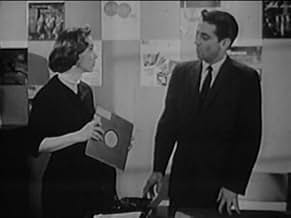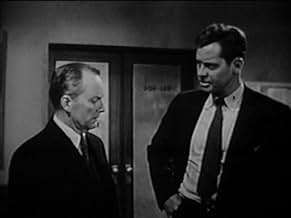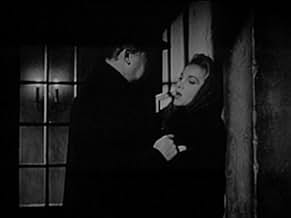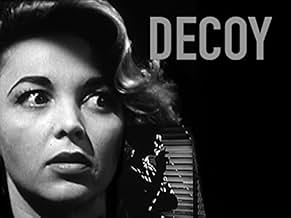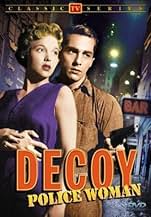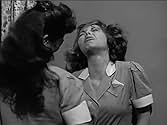Adicionar um enredo no seu idiomaNew York City policewoman Casey Jones' assignment to fight crime often entails her going undercover in some of the seediest and most dangerous parts of the city.New York City policewoman Casey Jones' assignment to fight crime often entails her going undercover in some of the seediest and most dangerous parts of the city.New York City policewoman Casey Jones' assignment to fight crime often entails her going undercover in some of the seediest and most dangerous parts of the city.
Explorar episódios
Avaliações em destaque
Yes, this is a wonderfully gritty, no-nonsense cop yarn. What struck me is: Where's the sexism? Where's the condescension? Where's the "Oh, ya gonna arrest me, Officer Sweetie Pie?" This was the Fifties, right? It's a cop show with a twist: a cop who gets emotional over what she sees and what she has to do. But Casey Jones never, and I mean never, lets it get in the way of her completely professional approach to her job. She works with male officers, and they are nothing if not equals, comrades in arms. And for those of you who know Beverly Garland only from the fluff of My Three Sons, have you got a surprise coming. Great entertainment all the way around. And for something a little snappier, try Front Page Detective.
This show took me completely by surprise. When it showed up on my suggested list, on a whim I watched the 1st episode and was hooked.
It's been called the female Dragnet but in my opinion it is better. The topics are timely even for today and definitely ahead of it's time for 1958. Filmed entirely in NYC, it is a enlightening snapshot of the city in the 50's with many of the structures looking exactly the same to this day. Also of note are the many actors appearing in Decoy who would go on to become household names.
Don't let the name or age of the show dissuade you. I think American TV audiences were just not ready for an empowered female lead in a series and that's a shame because personally, I would have liked to have seen a few more seasons.
It's been called the female Dragnet but in my opinion it is better. The topics are timely even for today and definitely ahead of it's time for 1958. Filmed entirely in NYC, it is a enlightening snapshot of the city in the 50's with many of the structures looking exactly the same to this day. Also of note are the many actors appearing in Decoy who would go on to become household names.
Don't let the name or age of the show dissuade you. I think American TV audiences were just not ready for an empowered female lead in a series and that's a shame because personally, I would have liked to have seen a few more seasons.
Most lead characters on TV cop shows in the 1950s and 60s were guys. Decoy was a departure from the usual fare by casting Beverly Garland as Policewoman Casey Jones. Amazon Prime currently has all episodes available.
"Decoy," a title fitting perfectly with Casey's assignments, would have benefited with the more marketable name "Policewoman." Surprisingly the classictvhistory.wordpress blog only mentions Decoy once in an article about Brenner, another late-50s Manhattan-based crime show. It deserves a detailed analysis.
What I first noticed about Decoy is the performance by the great Beverly Garland and her sympathetic yet no-nonsense, duty-bound and calm characterization. There is no humor whatsoever in Decoy, not even fatalistic police humor or the sardonic closing line of a conversation that Jack Webb practically patented in Dragnet. In her narration, she accepts her job with a sense of pessimism about the worst qualities of human nature that she knows will continue to repeat. What real policemen and policewomen see and deal with everyday would break the average person.
Then there's the world Casey lives in, when police science technology was still fairly crude and a lack of knowledge by the TV writers about the physical reality of criminal acts, something that continues in today's TV and films. She relies on her intuition and her ability to influence criminals to accept her so she can find the evidence or get the confession that allows her to slap the cuffs on them. There's very little gun play and shootouts, no insane car chases or gun glorification that's filled TV screens for decades and there's not much physical violence, something that Angie Dickinson's Policewoman would make up for in the more permissive 1970s, adding sexual themes and an emphasis on Dickinson's sex appeal to the mix.
The black and white location shooting of New York City and outer boroughs, when the city was heading to a decline adds a huge downbeat, melancholy tone. The dirty streets, sense of decay and crumbling tenements that Naked City also captured (and Hawk did in color in the 60s) creates a moody, grim feel to Casey's thankless job. The threadbare, shabby studio sets, a standard in 50s TV, reinforces that atmosphere. The brief, opening theme music to Decoy is stock, used in several earlier movies, and creates a sense of impending doom that sets the pace.
Casey solves her cases with a sense of fatalism, knowing that solving a case doesn't close the book on the tragedy in the wake of a crime. Families are destroyed, reputations are tarnished.
Later on, Beverly Garland opened the Beverly Garland hotel in Studio City. I occasionally attended movie collectible shows at the hotel but never had the chance to meet her and get an autograph. Now called The Garland as of 2014, it was built by her second husband.
"Decoy," a title fitting perfectly with Casey's assignments, would have benefited with the more marketable name "Policewoman." Surprisingly the classictvhistory.wordpress blog only mentions Decoy once in an article about Brenner, another late-50s Manhattan-based crime show. It deserves a detailed analysis.
What I first noticed about Decoy is the performance by the great Beverly Garland and her sympathetic yet no-nonsense, duty-bound and calm characterization. There is no humor whatsoever in Decoy, not even fatalistic police humor or the sardonic closing line of a conversation that Jack Webb practically patented in Dragnet. In her narration, she accepts her job with a sense of pessimism about the worst qualities of human nature that she knows will continue to repeat. What real policemen and policewomen see and deal with everyday would break the average person.
Then there's the world Casey lives in, when police science technology was still fairly crude and a lack of knowledge by the TV writers about the physical reality of criminal acts, something that continues in today's TV and films. She relies on her intuition and her ability to influence criminals to accept her so she can find the evidence or get the confession that allows her to slap the cuffs on them. There's very little gun play and shootouts, no insane car chases or gun glorification that's filled TV screens for decades and there's not much physical violence, something that Angie Dickinson's Policewoman would make up for in the more permissive 1970s, adding sexual themes and an emphasis on Dickinson's sex appeal to the mix.
The black and white location shooting of New York City and outer boroughs, when the city was heading to a decline adds a huge downbeat, melancholy tone. The dirty streets, sense of decay and crumbling tenements that Naked City also captured (and Hawk did in color in the 60s) creates a moody, grim feel to Casey's thankless job. The threadbare, shabby studio sets, a standard in 50s TV, reinforces that atmosphere. The brief, opening theme music to Decoy is stock, used in several earlier movies, and creates a sense of impending doom that sets the pace.
Casey solves her cases with a sense of fatalism, knowing that solving a case doesn't close the book on the tragedy in the wake of a crime. Families are destroyed, reputations are tarnished.
Later on, Beverly Garland opened the Beverly Garland hotel in Studio City. I occasionally attended movie collectible shows at the hotel but never had the chance to meet her and get an autograph. Now called The Garland as of 2014, it was built by her second husband.
A couple of years ago, I was able to get a set of 5 DVDs that contained 20 of the 39 episodes of Decoy, and it was great to watch them again after so long. Back when Decoy aired in 1957-58, I was 12 and 13 years old and had something of a crush on Beverly Garland. Recently, I found an advertisement--for the first time--for a DVD set with all 39 episodes. And the price was hard to beat as well. Naturally, I ordered the set and have been enjoying watching them all over again.
The picture quality is excellent, but at times the sound is a little muffled; however, all in all, it is great viewing. For anyone who enjoys the genre of Dragnet, Police Woman, etc., this is a great series that ran, sadly, for only one season. Yet, I consider it to be a classic.
The picture quality is excellent, but at times the sound is a little muffled; however, all in all, it is great viewing. For anyone who enjoys the genre of Dragnet, Police Woman, etc., this is a great series that ran, sadly, for only one season. Yet, I consider it to be a classic.
One would call "Decoy" for what it is... a female "Dragnet", with the beguiling Beverly Garland ("My Three Sons", "Scarecrow and Mrs. King") and the city of New York filling in for Jack Webb and sunny Los Angeles. But once you get caught in its premise, it's easy to overlook other aspects of the show. Such as the fact that Ms. Garland is required, in her role as undercover policewoman Patricia "Casey" Jones, to play a different role in each of the 39 episodes filmed. In one episode, she could play an exotic dancer in a carnival, in the next, she can play an addict, and so on and so on, all in the guise of a crime fighter. Whether Angie Dickinson, as Pepper Anderson - "Police Woman", took her cues from Beverly Garland is open to debate, but it's clear to say that Ms. Garland's Casey Jones is clearly a trailblazer for other lady lawmen to follow.
As for the other co-star, New York City... "Decoy" isn't the first series filmed on location in the Big Apple, nor was it the last, but it was certainly one of the most effective in terms of its film noir look and fully fleshed characters. This isn't "Naked City", but it's as close a similarity as you can get on a shoestring budget. And it does the city justice, as "Naked City" would do the next year. Check it out on DVD when you get the chance.
"Decoy" is a Pyramid Production in association with Official Films, Inc. with technical assistance from the Policewoman's Bureau, NYC Police Department. 39 episodes were filmed on location in 1957.
As for the other co-star, New York City... "Decoy" isn't the first series filmed on location in the Big Apple, nor was it the last, but it was certainly one of the most effective in terms of its film noir look and fully fleshed characters. This isn't "Naked City", but it's as close a similarity as you can get on a shoestring budget. And it does the city justice, as "Naked City" would do the next year. Check it out on DVD when you get the chance.
"Decoy" is a Pyramid Production in association with Official Films, Inc. with technical assistance from the Policewoman's Bureau, NYC Police Department. 39 episodes were filmed on location in 1957.
Você sabia?
- CuriosidadesThe first cop show with a female protagonist.
- Cenas durante ou pós-créditosOpening credits include the dedication: "Presented as a tribute to the BUREAU OF POLICEWOMEN Police Department City of New York."
Principais escolhas
Faça login para avaliar e ver a lista de recomendações personalizadas
- How many seasons does Decoy have?Fornecido pela Alexa
Detalhes
- Tempo de duração
- 30 min
- Cor
- Mixagem de som
- Proporção
- 1.33 : 1
Contribua para esta página
Sugerir uma alteração ou adicionar conteúdo ausente


